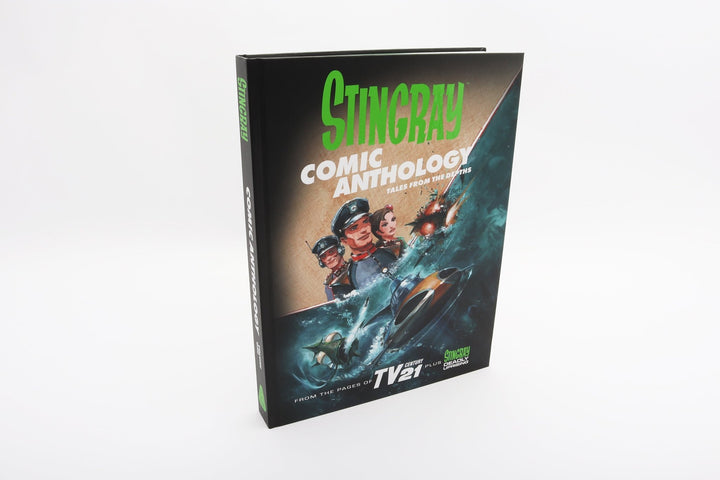Thunderbirds Thursday: 5 Reasons There Should Have Been a Zero X TV Series

Thunderbirds Are Go is many things: Thunderbirds' debut movie, Century 21 Productions' own first foray into transplanting their marionette marvels on the big screen, and a musical treat for Cliff Richard fans (probably). Frustratingly, the movie has come to be recognised for its lack of focus on the ensemble Tracy family and instead devotes a large amount of screentime to Zero X. The colossal multi-part spacecraft serves as a perfect visual metaphor for Century 21's distinct brand of sci-fi entertainment.
Despite the craft's star focus, its eventual reappearance in Captain Scarlet, and a long-lasting presence in comics, annuals and more, a Zero X TV series never emerged during the later years of Century 21's busy output. This Thunderbirds Thursday, we're investigating why we should have had a Zero X TV series and what the series might have been about!
5. Growing absence of space-based scenarios

Isn't it strange how, despite Fireball XL5's transatlantic success, Thunderbirds, Captain Scarlet, Joe 90, and The Secret Service grew comfortable with mostly Earth-based series? Several episodes from those series are indeed space-based, but Thunderbirds in particular rarely utilises Thunderbird 3 as much as it could have, with the series becoming content to focus on Earth-based rescue disasters. Similarly, Captain Scarlet's interplanetary war adds a galactic element, but the war of nerves itself mostly takes place on Earth.
During these peak years of Century 21's output then, there remains a noticeable absence of space-based storytelling, a void which surely a Zero X TV series could have easily fulfilled, and increased Thunderbirds' credentials for its depiction of advances in space technology. The starship's brilliantly realised comic strip in TV Century 21 thrillingly captures the potential offered by this idea, catapulting Captain Paul Travers and crew into the furthest depths of the cosmos and encountering a memorably bizarre and frightening array of cosmic horror that both steals some of Star Trek's thunder and serves as a proof-of-concept for Space: 1999. Transplanting that into the cinema-for-television scale of jeopardy and wonder that Century 21 Productions specialised in could have been such a galactic feather in the company's cap.
4. Galactic special effects

A Zero X TV series raises intrigue for how Century 21's growingly sophisticated special effects might have been realised in a predominately space-based series. Zero X's encounter with the Rock Snakes in Thunderbirds Are Go remains the most tangible indicator for what a Zero X series could have delivered in terms of spectacular visual effects. No longer caught in the trappings of black and white, and with the vastly increased budget and film-making resources at their disposal, the mind boggles as to how much of a leap Zero X's depiction of outer space could have been compared to Fireball XL5. What might Zero X's encounters with further alien worlds have looked like? Worlds far beyond our own Solar System, yet still maintaining a grounded visual believability that anchors many of the later-era Supermarionation series in their depictions of sci-fi and spy-fi tropes.
3. Increasingly sophisticated production design

Spinning off still further from the previous reason, matching those advanced special effects could have been an increasingly renewed approach to the visual design inhabited by the puppets. The likes of visual effects director Peter Wragg (the man in charge of many of the second units for visual effects on the post-Thunderbirds series) and model maker/designer Mike Trim were taking on increasing responsibilities while the more senior staff dedicated their efforts to the movies.
Joe 90 and The Secret Service feature some of the most wonderfully elaborate and painstakingly crafted set designs of any of the puppet series, with everything now built to match the perfect proportions of the newly designed puppets. This renewed approach to creative and colourful set pieces for the puppets to inhabit would undoubtedly have some in handy for the cosmic Cold War that could have possibly been showcased in a TV extension of Zero X.
2. The merchandise machine

Century 21 Productions had long since proven its success in merchandise exploitation. The company's TV series spawned numerous lines of toys, dolls, role-play gear, audio productions, comics, books, annuals and beyond. Zero X's muscular presence throughout TV Century 21's own line-up of comics and annuals suggests even further merchandise couldn't have harmed its success. Intriguingly, the few Zero X toys that did emerge didn't exactly fly off of the shelves. Century 21's head of merchandise, Keith Shackleton, recalls that a remote controlled Zero X toy, with the ability to disassemble into its various individual sections, actually didn't sell like hot cakes.
More successful by comparison was Project S.W.O.R.D., an ongoing plethora of imaginative space-age vehicles imported from overseas and brought under Century 21's wing for mass consumption. Evidently, a demand for cosmic-flavoured toy vehicles outside of Thunderbirds, Captain Scarlet or Joe 90 was there from young audiences. Zero X even became part of the Project S.W.OR.D. world in lieu of its own TV series or further adventures on the big screen.
1. Mature storytelling

With the advancements of Supermarionation came greater emphasis on darker and more mature storytelling. Not to say Thunderbirds was absent of such things or that the later works are devoid of a sense of humour found in the likes of Supercar and Fireball XL5. But there's a sense that these shows increasingly 'grew up' as they progressed. The caricatured alien menaces of Fireball XL5 are nowhere to be found in Captain Scarlet, who's own space-based episodes, such as Shadow of Fear, Noose of Ice and the Lunarville 7 trilogy, offer a far more mature and realistic approach to the adventure and dangers of mankind's growing dominance of the stars. The advanced mechanics of space travel in the world of Zero X don't call for oxygen pills!
The stories of a Zero X TV series would also have perhaps allowed for a deeper dive into the characters themselves, who admittedly come away from Thunderbirds Are Go as blank slates. What heroic qualities does Captain Paul Travers have that no other Anderson space-age protagonist have? What of co-pilot Gregg Martin, navigator Brad Newman, and Doctor Ray Pierce? Is Space Colonel Harris any gruffer than Commander Shore? Any less empathetic than Jeff Tracy? These questions and more would surely have been answered by further Zero X adventures on the small screen.
The imaginative possibilities conjured up by the starship's brief onscreen lifespan leave us with plenty to ponder over. Whilst Century 21 Productions would embrace fresh challenges in the wake of Thunderbirds' premature end, a Zero X television series remains one of the company's great 'what ifs'.
To be the first to hear about the latest news, exclusive releases and show announcements, sign up to the Anderson Entertainment newsletter!




![Thunderbirds Comic Anthology Volume One [HARDCOVER] - The Gerry Anderson Store](http://gerryanderson.com/cdn/shop/files/thunderbirds-comic-anthology-volume-one-hardcover-8030771.jpg?v=1751089031&width=720)
![All Sections Alpha: The Making of Space: 1999 [HARDCOVER] - The Gerry Anderson Store](http://gerryanderson.com/cdn/shop/files/all-sections-alpha-the-making-of-space-1999-hardcover-7498116.png?v=1757766647&width=720)

![Stingray Comic Anthology Volume Two – Battle Lines [HARDCOVER] - The Gerry Anderson Store](http://gerryanderson.com/cdn/shop/files/stingray-comic-anthology-volume-two-battle-lines-hardcover-107681.jpg?v=1738856151&width=720)
![Stingray W.A.S.P. Technical Operations Manual Standard Edition [HARDCOVER] - The Gerry Anderson Store](http://gerryanderson.com/cdn/shop/files/stingray-wasp-technical-operations-manual-standard-edition-hardcover-112278.jpg?v=1749664163&width=720)
![Stingray WASP Technical Operations Manual Special Limited Edition [HARDCOVER BOOK] - The Gerry Anderson Store](http://gerryanderson.com/cdn/shop/files/stingray-wasp-technical-operations-manual-special-limited-edition-hardcover-book-991914.jpg?v=1749657538&width=720)
![Stingray: The Titanican Stratagem – Signed Limited Edition [HARDCOVER NOVEL] - The Gerry Anderson Store](http://gerryanderson.com/cdn/shop/files/stingray-the-titanican-stratagem-signed-limited-edition-hardcover-novel-129251.jpg?v=1740558711&width=720)







